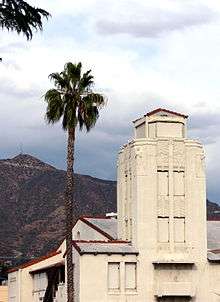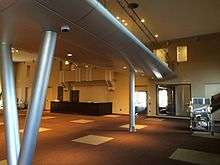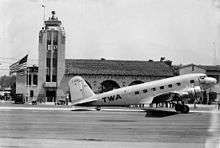Grand Central Airport (California)



Grand Central Airport, Glendale, California, also known as Grand Central Air Terminal (GCAT), was an important facility for the growing Los Angeles suburb of Glendale in the 1920s. It was also a key element in the development of United States aviation. The terminal, located at 1310 Air Way, was built in 1928 and still exists, owned since 1997 by The Walt Disney Company. Three hangars also remain standing. The location of the single concrete 3,800-foot (1,200 m) runway has been preserved, but is now a public street as the runway was dug up[1] and converted into Grand Central Avenue.
Beginnings
The concept for the airport probably began with Leslie Coombs Brand (1859–1925), a major figure in the settlement and economic growth of the Glendale area. He had purchased land on the lower slopes of Mount Verdugo overlooking the city, and in 1904 built an imposing residence that became known as Brand Castle (which today houses the Brand Library). Just across the mostly dry Los Angeles River he could see the Griffith Park Aerodrome's grass field, built in 1912. Just three years later he decided to build his own grass airstrip below his mansion. He built his first hangar in 1916 [2] and put together a fleet of planes, and held fly-in parties.[3] The only requirement was that guests had to arrive in their own planes and bring passengers.[4]

From this modest beginning, plans were soon hatched by local entrepreneurs to establish an airport with commercial possibilities a little further down below his field. In 1923 the 112-acre (0.45 km2) Glendale Municipal Airport opened with a 100 ft (30 m). wide paved runway 3,800 ft (1,200 m). long, and came to be renamed "Grand Central Air Terminal" when it was purchased by other venture capitalists, who expanded it to 175 acres (0.71 km2). Aerial view looking SE On February 22, 1929 a terminal with a control tower had been built, and was opened to much fanfare. Designed by Henry L. Gogerty,[5] the intention was to construct an air terminal along the lines of a classic railroad terminal. It combined a style consisting of Spanish Colonial Revival with Zig-zag Moderne influences (Art Deco).[6] GCAT became a major airport of entry to Los Angeles and provided the first paved runway west of the Rocky Mountains.
Within a year, the entire enterprise was sold to a group calling itself the Curtiss-Wright Flying Service,[7] managed by Major C. C. Moseley, a co-founder of the future Western Airlines. It became the city's largest employer.[8] It was also at Grand Central that Major Moseley established the first of his private flying schools, Curtiss-Wright Technical Institute (later renamed Cal-Aero Academy).
Pioneering people at GCAT
Many famous aviation pioneers made their home and their mark at GCAT, as pilots, designers, mechanics, teachers, salesmen, and airplane/power-plant builders, often serving in some combination, including:
- Charles Lindbergh, who piloted the nation's first regularly scheduled coast to coast flight from Grand Central's runway as organizer of Transcontinental Air Transport which, after merging with Western Air Express, came to be Transcontinental and Western Air TWA.
- Amelia Earhart used the airport and bought her first plane there.[9]
- Wiley Post used the airport.
- Laura Ingalls became the first woman to fly solo across the country when she landed at Glendale in 1930.
- Albert Forsythe and Charles Anderson were the first African American pilots who made the transcontinental flight, completed at Glendale in 1933. Their achievement paved the way for the black Tuskegee Airmen who fought in World War II.
- Thomas Benton Slate built an all-metal dirigible and hangar in 1925.[10] It was 212 ft (65 m). long, and supposedly fireproof. He named it "City of Glendale", and it left the ground briefly in 1929, popped some rivets, and crashed.[11]
- Howard Hughes built his record-setting H-1 Racer in a small building at 911 Air Way in 1935, thus beginning the Hughes Aircraft Company.[12] The building burned to the ground in the late 1990s.
- Jack Northrop started his 'Avion Aviation' company on the field in 1927, where he built multi-cellular metal structures.
- William Boeing bought the business from Northrop, and moved it to Burbank's United Airport (now Bob Hope Airport).
- W. B. (Bert) Kinner built Amelia Earhart’s first plane, the Kinner Airster. He was the inventor of the compound folding wing.
- Major C. C. Moseley established overhaul facilities there, and operated a flight academy whose pilot and mechanic graduates traveled to Europe as the all-volunteer Eagle Squadron who flew against Hitler at the Battle of Britain before the country entered the war.
- Actor Robert Cummings was an active pilot and flight instructor who used this airport.[13]
In addition, airlines originating at GCA included TWA,[14] Varney, Western, and Pickwick Airlines (1928–30).
Movies and movie stars
[15] The airport was the setting of several films, including Howard Hughes' Hell's Angels (1930), Shirley Temple's Bright Eyes (1934), Lady Killer (1933) starring James Cagney, Sky Giant (1938) with Joan Fontaine, Hats Off (1936) with John Payne, the musical Hollywood Hotel (1937) with Dick Powell, and the adventure film Secret Service of the Air (1939) starring Ronald Reagan. Episodes of the 1941 movie serial, Sky Raiders, show the terminal and other GCAT structures. The terminal was a favorite shooting location.[16]
The airport was also known for stunt flying,[17] and supplying planes for use in the movie industry by people like Paul Mantz. Just about every airplane design flying during the 1920s, 1930s and 1940s could be seen at GCAT for use in movies, or there to be serviced.[18]
Wartime
When Pearl Harbor was attacked on December 7, 1941, Grand Central Airport (like all other west coast airports) was immediately closed to private aviation. (The remaining airlines had already moved to Burbank.) The government moved in, heavily camouflaged the place, and converted it into an important defense base for Los Angeles. In 1942 the runway, which originally ended at Sonora Avenue, was extended North to Western Avenue, giving it a 5,000' length to accommodate large airplanes and future jet aircraft.
Began training United States Army Air Forces flying cadets under contract to Grand Central Flying School; Cal-Aero Training Corporation, and Polaris Flight Academy. Assigned to West Coast Training Center (later Western Flying Training Command) as a primary (level 1) pilot training airfield. Also instructed Royal Air Force flying cadets. Flying training was performed with Fairchild PT-19s as the primary trainer. Also had several PT-17 Stearmans
A P-38 training base was built on the west side near the river which prepared pilots for the 319th Fighter Wing, to be ready for action in Europe. Hundreds of P-51s, C-47s, B-25s and others transitioned through Grand Central Airport in Glendale for refurbishment and reconditioning. Larger aircraft, like the B-29, were sent to the Grand Central Service Center in Tucson, Arizona.
Postwar
In 1947 the runway was cut back to 3,800' (southeast of Sonora Ave) due to pressure from local government.[19] The airport was returned to private use, renamed Grand Central Airport, ceased to be profitable, and was closed in 1959 [20] to make way for the development of the Grand Central Business Park. Before its closing, the airport hosted a SCCA sports car race on November 13, 1955 that attracted 6,000 spectators.
Today, the location houses several corporate offices of The Walt Disney Company and is the headquarters for Walt Disney Imagineering. For a number of years the southwest corner was used as a commercial helicopter base. That space is now occupied by the DreamWorks Animation SKG production company. The city of Glendale retains some interest in aviation, for it is part owner of the Bob Hope Airport (formerly "Burbank-Glendale-Pasadena Airport").
Rocketry
Major Corliss C. Moseley established the Grand Central Rocket Company in the vicinity of Grand Central Air Terminal in 1955.[21] It was there that the third stages of early Vanguard rockets, including the first two to reach orbit, were built.[22]
Renovation
In April 2013, Glendale’s Historic Preservation Commission voted unanimously to approve the Walt Disney Company's plan for the restoration of the Grand Central Airport terminal building, including extensive structural stabilization and seismic upgrades, restoration of the exterior and rehabilitation of significant interior spaces, so that the building could be adaptively reused as a visitor center, offices and event space for the surrounding Disney Grand Central Creative Campus. According to the 2000 agreement between the city of Glendale and Disney, limited public access was required, probably through a reservation system. The plans included a media wall and interpretive displays featuring the history of Grand Central Airport. Many of the project renderings showed an airplane in front of the restored building.[23] The work was completed by PCL Construction Services, Inc., located in Glendale, CA.
See also
Notes
![]() This article incorporates public domain material from the Air Force Historical Research Agency website http://www.afhra.af.mil/.
This article incorporates public domain material from the Air Force Historical Research Agency website http://www.afhra.af.mil/.
- ↑ demolishing the runway
- ↑ Brand mowing his landing strip in front of his hangar
- ↑ Fly-in party
- ↑ Brand greets movie star Ruth Roland at his fly-in party
- ↑ Henry Gogerty bio,
- ↑ Grill room and dance floor 1930.
- ↑ Curtiss-Wright Flying Service
- ↑ Curtiss-Wright Flying Service
- ↑ Amelia Earhart at GCA
- ↑ Promotional brochure
- ↑ City of Glendale ready to go
- ↑ Howard Hughes and his H-1 Racer
- ↑ Flying magazine- March, 1960.
- ↑ TWA at terminal
- ↑ Chaplin arrives
- ↑ List of movies using this location
- ↑ Rodeo event
- ↑ Memories of Herb Torberg
- ↑ Aerial pic looking SE
- ↑ The last plane lands
- ↑ Underwood, John (2006). Grand Central Air Terminal. ISBN 0-7385-4682-8.
- ↑ To Reach the High Frontier: A History of U.S. Launch Vehicles. University Press of Kentucky. 2002.
- ↑ http://tropicostation.blogspot.com/2013/03/glendale-approves-disneys-grand-central.html
External links
| Wikimedia Commons has media related to Grand Central Air Terminal. |
- Aviation History of the San Fernando Valley
- video
- Paul Freeman's collection of photographs concerning abandoned airfields
- Grand Central Air Terminal - Images of Aviation by John Underwood
- Historic American Buildings Survey (HABS) No. CA-2728, "Grand Central Air Terminal, 1310 Air Way, Glendale, Los Angeles County, CA"
- Map and more GCAT history
Coordinates: 34°09′47″N 118°17′12″W / 34.1630°N 118.2867°W
.svg.png)